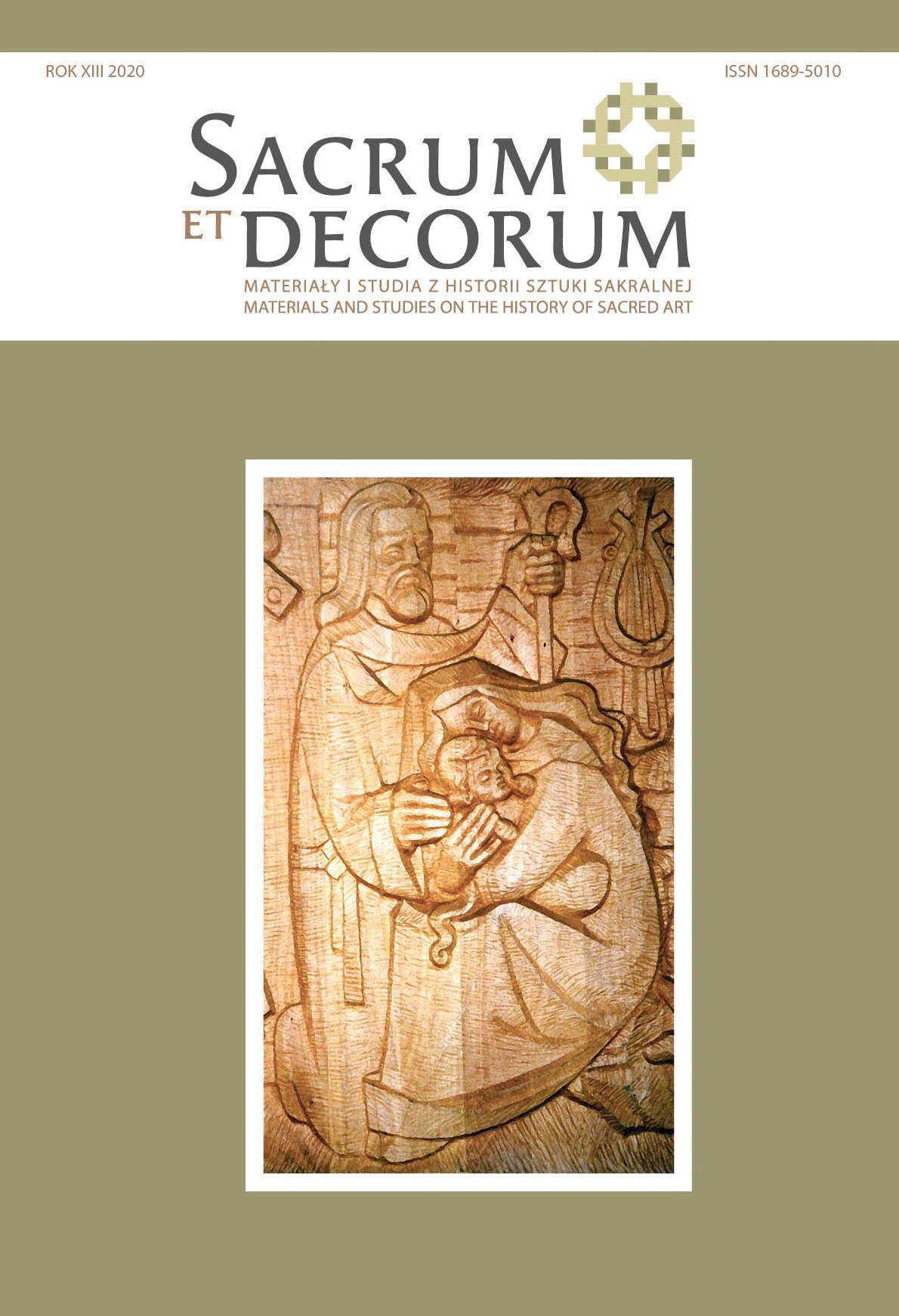The transformations of the symbolic and theological meaning of matter reflected in Christian aesthetics and art
DOI:
https://doi.org/10.15584/setde.2020.13.2Keywords:
Creator, creation, dogma, art, matter, aesthetics, lightAbstract
Almost from its very beginning, the faith of the Church incorporated art in its various forms of expression into the process of interpreting its doctrine. Quite quickly the Church included in this process the dogma of creation, i.e. the calling of the world into existence by God. At first, in polemic against ancient Manichaean tendencies, this dogma contributed to a positive view of matter, and thus to the possibility of using it in the realm of religion: since it comes from God, it cannot be an obstacle to worshipping him. Over time, the theme of creation itself was also incorporated into art, above all because it shaped Christian aesthetics, which always in some way reflected the essential elements of the Christian vision of the world and matter: radiance, proportion, harmony. Scholastic theologians in the Middle Ages drew attention to the fact that aesthetics, referring to the creative work of God, can play a supportive role in man's return to God, thanks to the fact that it lifts his spirit towards the Creator. In the Middle Ages the motif of God the Creator, especially as the Creator of all things, also appeared in art. Under the influence of Enlightenment and positivist tendencies, matter lost its symbolic and theological bearing, becoming only a material made available to man, and thus the motif of creation disappeared from art. This means that there is a need to search for the possibility of including the truth about creation in art.Downloads
References
Agnoli F., Roberto Grossatesta. La filosofia della luce, Bologna 2007.
Baschet J., L’iconographie médievale, Paris 2008.
Biffi I., Mirabile medioevo, Milano 2009
Boespflug F., Dieu au compass. Histoire d’une motif et de ses usages, Paris 2017.
Boespflug F., Dieu et ses images, Paris 2017.
Boespflug F., Dottrina delle immagini, immagini della dottrina. Meditazione storico-teologica, w: La sapienza del cuore. Omagio a Enzo Bianchi, Torino 2013.
Boespflug F., Le Créateur au compas. Deus geometra dans l’art d’Occident (IXe – XIXe siècle), „Micrologus” 19 (2011).
Chenu M.-D., La teologia nel dodicesimo secolo, Milano 1986.
Chenu M.-D., Teologia materii.Cywilizacja techniczna i duchowość chrześcijańska, tłum. O. Scherner, Paris 1969.
Congar Y., Le theme du Dieu créateur et les explications de l’Hexaemeron dans la tradition chrétienne, w: L’homme devant Dieu. Mélanges offerts au P. Henri de Lubac, t. 1, Paris 1964.
Cuttini E., Ars, w: Dizionario bonaventuriano. Filosofia, teologia, spiritualità, red. E. Caroli, Padova 2008.
Jan Damasceński, II mowa obronna przeciw tym, którzy odrzucają święte obrazy (Contra imaginum calumniatores), 13–14 [tłum. M. M. Dylewska], „VoxPatrum” 25 (2005) t. 48.
Del Zotto C., La teologia dell’immagine in San Bonaventura, Vicenza 1977.
Die philosophischen Werke des Robert Grosseteste, Bischofs von Lincoln, red. L. Baur, Münster 1912.
Duby G., Czasy katedr. Sztuka i społeczeństwo 980–1420, tłum. K. Dolatowska, Warszawa 1997.
Eco U., Il problema estetico in San Tommaso, Torino 1956.
Forestier S., N. Hazan-Brunet, E. Kuzmina, Chagall. Viaggio nella Bibbia. Studi inediti e gouaches, Milano 2014.
Gibert P., Quand les peintres lisaient la Bible. L’exégèse des peinters à la Renaissance, Paris 2015.
Gilson E., Saint Bernard. Un itinéraire de retour à Dieu, Paris 2011.
Guglielmo di Saint-Thierry, Bernardo di Chiaravalle, Pietro Abelardo. Una controversia teologica del XII secolo, red. F. Troncarelli, Brescia 2010.
von Harnack A., Das Wesen des Christentums. Sechzehn Vorlesungen vor Studiereden aller Fakultäten im Wintersemester 1899-1900 an der Universität Berlin, Leipzig 1901.
Hugo W., Katedra Marii Panny w Paryżu, tłum. H. Szumańska-Gross, Warszawa 2005.
Hugon ze Świętego Wiktora, Didascalicon czyli co i jak czytać, tłum. P. Pludra-Żuk, wstęp J. Soszyński, komentarz P. Pludra-Żuk, J. Soszyński, Warszawa 2017.
Królikowski J., L’aspetto soteriologico del manicheismo primitivo e le possibili cause della sua attrattiva, w: Pagani e cristiani alla ricerca della salvezza (secoli I-III). XXXIV Incontro di studiosi dell’antichità cristiana, Roma, 5-7 maggio 2005, Roma 2006.
Leclercq J., Essais sur l’esthétique de S. Bernard, „Studi Medievali” 9 (1968).
Łukaszuk T.D., Ikona w życiu, w wierze i w teologii Kościoła, Kraków 2002.
Mâle E., L’art religieux du XIII siècle en France, Paris 1922.
Mariani G., La luce, Roma 2005.
Maritain J., Georges Rouault, New York 1952.
McMullin E., Ewolucja i stworzenie, tłum. J. Rodzeń, Kraków 2014.
Metafizyka obecności. Inspiracje religijne w dziełach artystów krakowskich 2000-2019, red. B. Stano, A. Daca, Kraków 2019.
Mews C.J., Bernard of Clairvaux and Peter Abelard, w: A Companion to Bernard of Clairvaux, red. B. P. McGuire, Leiden–Boston 2011.
Morfologia sztuki. Współczesne oblicza transcendencji. Międzynarodowe sympozjum. Akademia Sztuk Pięknych im. Jana Matejki, Wydział Rzeźby, 1–2 grudnia 2016 r., Kraków 2019.
Rationale divinorum officiorum Guillelmi Duranti Liber I et II, red. G.F. Freguglia, Città del Vaticano, 2001.
Schönborn Ch., Ikona Chrystusa, tłum. W. Szymona, Poznań 2001.
Sedlmayr H., Verlust der Mitte. Die bildende Kunst des 19. und 20. Jahrhunderts als Symptom und Symbol der Zeit, Salzburg 1998.
Tatarkiewicz W., Historia estetyki, t. 2: Estetyka średniowieczna, Warszawa 1988.
Tertulian, De resurrectione carnis 8, 2, w: Katechizm Kościoła katolickiego, Poznań 2002, nr 1015.
Tomasz z Akwinu, Summa theologiae I q. 5 a. 4 ad 1.
Verger J., JolivetJ., Bernardo e Abelardo, Il chiostro e la scuola, Milano 1989.
Wąsek D., Koncepcja teologii Piotra Abelarda, Kraków 2010.
Zambruno P.S., La bellezza che salva. L’estetica di Tommaso d’Aquino, Napoli 2008.
Downloads
Published
How to Cite
Issue
Section
License
Copyright (c) 2020 Sacrum et Decorum

This work is licensed under a Creative Commons Attribution-NonCommercial-NoDerivatives 4.0 International License.
In line with the Open Access policy, authors retain full copyright to their articles – without restrictions.
Authors can deposit their articles in a repository of their choice.


